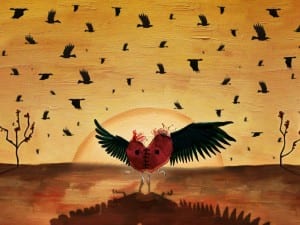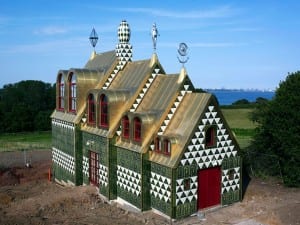As the title suggests, Going Public resurrects a large number of important art works, taking them out of the storerooms and archives of private collectors and placing them before the general public. In a sort of art-takeover, the exhibition inhabits five spaces in Sheffield’s city centre, each presenting a different collection. One of the collectors involved, Patrizia Sandretto Re Rebaudengo, notes: “I think I have been lucky that I can collect… the collector has a responsibility to give back.” It is this notion of “giving back” that is at the heart of Going Public, as it opens up significant practices, philosophies and art movements to the residents of Sheffield for free.
Millennium Gallery, Sheffield’s largest white cube space, plays host to some of the largest installation pieces in the showcase. Housing the Cattelain Collection, the gallery celebrates Minimal and Conceptual art from the 1960s and 1970s. Including work by Dan Flavin, Sol LeWitt and Anthony McCall amongst others, the exhibition opens with Do Ho Suh’s rather impressive Wielandstr. 18, 12159 Berlin (2011). The sizeable fabric and metal creation is the life-size reconstruction of an apartment with an incredible attention to detail, recapturing everything from the lampshades to the plug sockets in green material. Its flimsy and temporary appearance seems contrary to the way in which we usually perceive homes as secure, permanent elements of our lives. However, as Suh’s creation suggests, is it ever possible to truly inhabit a place?
The Cattelain Collection reflects Sol LeWitt’s sentiment that in Conceptual art “the idea itself, even if not made visual, is as much a work of art as any finished product.” Nearly all the works in this presentation demonstrate this thought in one way or another. From LeWitt’s empty cube frames to Flavin’s florescent lighting tubes, the audience will not see something that satisfies an aesthetic expectation, but plain industrial materials that throw out ideas about form, art and the process of creation. This is particularly true of Anthony McCall’s light installation, Meet You Halfway II (2009) where the viewer finds themselves in a pitch-black smoky room watching two white curves on a projector trying, but failing, to make a circle. The incomplete circle constantly eludes a satisfying conclusion, leaving the audience to search for and create concepts about the work themselves.
Meanwhile, over the road at Graves Gallery, the avant-garde work that makes up the Marzona Collection is a lot more directional in its clear depiction of what artistic practice should include. Based around the output of Marcel Duchamp, Dadaism and Surrealism, the presentation brings together not only artworks, but objects, letters, books, posters and photographs that provide a snapshot of this fascinating ideological approach to art. In Duchamp’s poster piece Dada 1916-1923 (1953) he defines Dada as something that “tried to destroy, not so much art, as the idea one had of art.” Indeed, this desire to break down the boundaries between what is perceived as art and what isn’t can be seen all over the Marzona Collection, in Man Ray’s photograph of Duchamp’s Bicycle Wheel, Kurt Schwitters’ use of sweet wrappers and Duchamp’s reinterpretation of familiar elements of the media – such as magazines and posters.
However, this concern is not limited to the 20th century: it continues to raise its head today all over the world. The dslcollection, which is on display at Site Gallery and SIA Gallery, features major pieces by the most prominent contemporary Chinese artists. Zhou Tao’s video 1,2,3,4 (2005) captures staff at various Chinese companies carrying out their regular morning exercises, while Liang Juhui’s One Hour of Pleasure (1996) records the artist playing video games in a lift. Both of these pieces combine ordinary activities with artistic intent and theoretical thought to raise political questions. In recontextualising content that is not necessarily “artistic” by its own merit, not only are the artists able to question what we perceive as art but the way in which their countries are governed.
Of all the spaces in Going Public, Sheffield Cathedral is arguably the most thought provoking. Due to the religious nature of the building, the art can never be viewed in isolation, but always under the banner of faith and systems of belief, which provokes a dynamic dialogue between the work and its surroundings. It is impossible to observe Cerith Wyn Evans’s In Girum Imus Nocte et Consumimur Igni (1996), translated as, “We go Round and Round in the Night and are Consumed by Fire” without considering the Christian concept of hell. Likewise, Berlinde De Bruyckere’s Marthe (2008) and Jake and Dinos Chapman’s Cyber Iconic Man (1996) are sculptures of distorted, naked figures, reminiscent of the depictions of Christ on the Cross often found in religious iconography. And Maurizio Cattelan’s Christmas ’95 (1995) specifically alludes to the star that directed the Magi to Bethlehem at Jesus’ birth.
Together, the collections involved in Going Public add meaning to a relatively straightforward title. Not only does Going Public refer to the public display of private works, but also the birth of radical new ideas into the mainstream that are (or were) controversial or unfavourable, such as Duchamp’s readymades or Minimalism’s simple and industrial formations. The questions and ideas thrown up by this excellent exhibition reflect universal concerns that continue to both probe and celebrate the role of art within the public sphere.
Going Public, in various venues across Sheffield, until 12 December.
For more information, visit www.goingpublicsheffield.org.
Hannah Clugston
Follow us on Twitter @AestheticaMag for the latest news in contemporary art and culture.
Credits
1. Do Ho Suh, Wielandstr. 18, 12159 Berlin, 2011. Courtesy of the artist and Lehmann Maupin Gallery.





